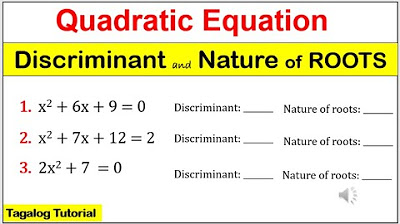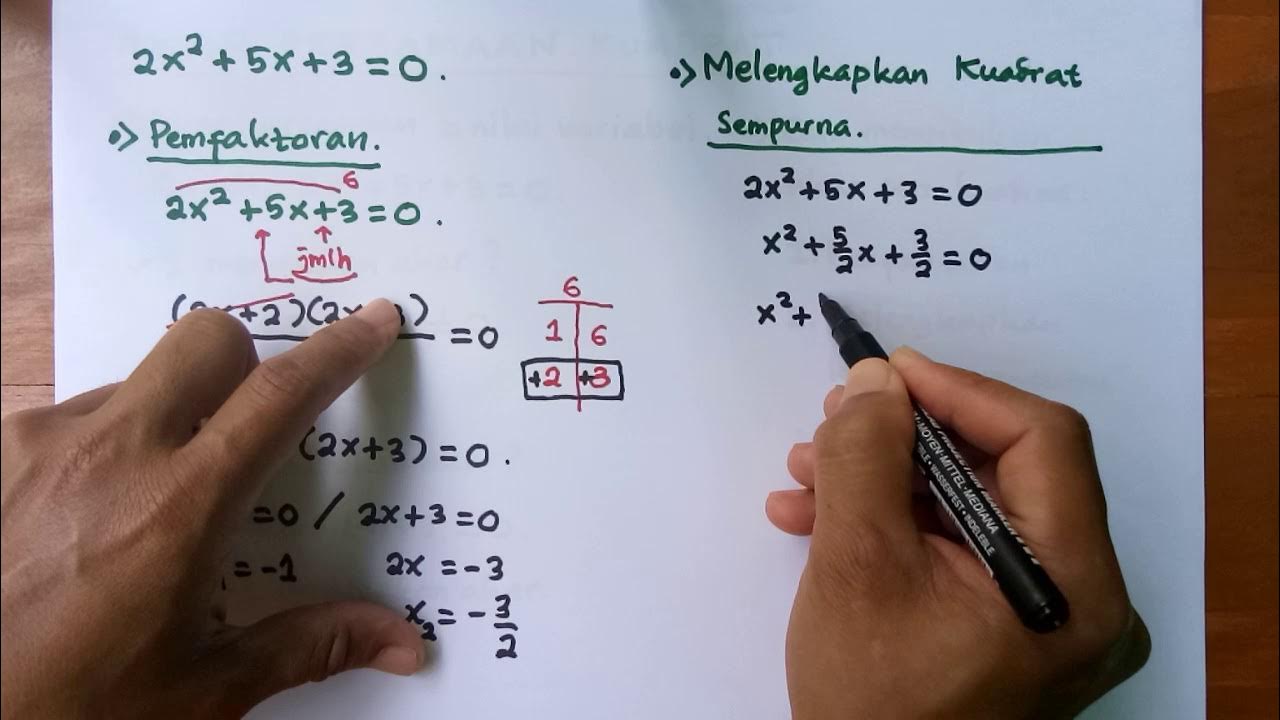Nature of Roots - Examples | Quadratic Equations | Don't Memorise
Summary
TLDRThis educational video script explains how to determine the nature of roots of a quadratic equation. It emphasizes the importance of the discriminant, b^2 - 4ac, in identifying whether roots are real and distinct, equal, or non-existent. The script guides through examples, showing how a discriminant of zero indicates equal real roots, a positive value suggests two distinct real roots, and a negative value means no real roots. It encourages viewers to solve and verify the nature of roots for three given quadratic equations.
Takeaways
- 📚 The nature of roots of a quadratic equation is determined by the discriminant, which is calculated as b^2 - 4ac.
- 🔍 If the discriminant is greater than zero, the equation has two distinct real roots.
- 🔄 If the discriminant equals zero, the equation has two equal real roots.
- 🚫 If the discriminant is less than zero, the equation has no real roots.
- 🧩 The first quadratic equation provided has a = 9, b = -12, and the discriminant is zero, indicating equal real roots.
- 🔢 For the first equation, the calculation of the discriminant is shown as (-12)^2 - 4 * 9 * 4 = 144 - 144 = 0.
- 📝 The second equation has a = 2, b = -9, and a positive discriminant, indicating two distinct real roots.
- 📉 The third equation's discriminant is negative, which means it has no real roots.
- 📚 The script encourages practice by solving the equations to verify the nature of the roots.
- 👨🏫 The explanation is instructional, guiding the learner through the process of determining the nature of roots for quadratic equations.
- 🎶 The script ends with a musical note, suggesting a conclusion or transition in the presentation.
Q & A
What is the general form of a quadratic equation?
-The general form of a quadratic equation is \( ax^2 + bx + c = 0 \), where \( a \), \( b \), and \( c \) are constants and \( a \neq 0 \).
What is the significance of the discriminant in a quadratic equation?
-The discriminant, denoted as \( \Delta = b^2 - 4ac \), determines the nature of the roots of a quadratic equation. If \( \Delta > 0 \), the equation has two distinct real roots; if \( \Delta = 0 \), it has two equal real roots; and if \( \Delta < 0 \), it has no real roots.
How do you calculate the discriminant for the quadratic equation \( 9x^2 - 12x + 4 = 0 \)?
-For the equation \( 9x^2 - 12x + 4 = 0 \), the discriminant is calculated as \( \Delta = (-12)^2 - 4 \times 9 \times 4 = 144 - 144 = 0 \).
What does a discriminant of zero indicate for the quadratic equation \( 9x^2 - 12x + 4 = 0 \)?
-A discriminant of zero indicates that the quadratic equation \( 9x^2 - 12x + 4 = 0 \) has two equal real roots.
What are the values of \( a \), \( b \), and \( c \) for the quadratic equation \( 2x^2 - 9x + 4 = 0 \)?
-For the equation \( 2x^2 - 9x + 4 = 0 \), the values are \( a = 2 \), \( b = -9 \), and \( c = 4 \).
How do you determine the nature of the roots for the quadratic equation \( 2x^2 - 9x + 4 = 0 \)?
-For the equation \( 2x^2 - 9x + 4 = 0 \), the discriminant is \( \Delta = (-9)^2 - 4 \times 2 \times 4 = 49 \). Since \( \Delta > 0 \), the equation has two distinct real roots.
What is the discriminant for the quadratic equation \( x^2 + 9x + 7 = 0 \)?
-For the equation \( x^2 + 9x + 7 = 0 \), the discriminant is \( \Delta = 9^2 - 4 \times 1 \times 7 = 81 - 28 = 53 \).
What does a positive discriminant signify for the roots of a quadratic equation?
-A positive discriminant signifies that the quadratic equation has two distinct real roots.
What are the steps to find the nature of the roots of a quadratic equation?
-The steps are: (1) Write down the quadratic equation in the form \( ax^2 + bx + c = 0 \), (2) Identify the values of \( a \), \( b \), and \( c \), (3) Calculate the discriminant \( \Delta = b^2 - 4ac \), and (4) Determine the nature of the roots based on the value of \( \Delta \).
Can a quadratic equation have complex roots?
-Yes, a quadratic equation can have complex roots if the discriminant is negative, as complex roots are not real numbers.
How can you verify the roots of a quadratic equation?
-You can verify the roots by substituting them back into the original equation and checking if both sides of the equation balance.
Outlines

Dieser Bereich ist nur für Premium-Benutzer verfügbar. Bitte führen Sie ein Upgrade durch, um auf diesen Abschnitt zuzugreifen.
Upgrade durchführenMindmap

Dieser Bereich ist nur für Premium-Benutzer verfügbar. Bitte führen Sie ein Upgrade durch, um auf diesen Abschnitt zuzugreifen.
Upgrade durchführenKeywords

Dieser Bereich ist nur für Premium-Benutzer verfügbar. Bitte führen Sie ein Upgrade durch, um auf diesen Abschnitt zuzugreifen.
Upgrade durchführenHighlights

Dieser Bereich ist nur für Premium-Benutzer verfügbar. Bitte führen Sie ein Upgrade durch, um auf diesen Abschnitt zuzugreifen.
Upgrade durchführenTranscripts

Dieser Bereich ist nur für Premium-Benutzer verfügbar. Bitte führen Sie ein Upgrade durch, um auf diesen Abschnitt zuzugreifen.
Upgrade durchführenWeitere ähnliche Videos ansehen

Jenis-jenis akar persamaan kuadrat || akar real berbeda, akar real sama, akar tidal real (IMAJINER)

Polinomial (Bagian 5) - Cara Menentukan Akar-akar Persamaan Polinomial

THE NATURE OF THE ROOTS OF A QUADRATIC EQUATION USING THE DISCRIMINANT || GRADE 9 MATHEMATICS Q1

Persamaan Kuadrat [Part 5] - Menyusun Persamaan Kuadrat Baru

MATH9 DISCRIMINANT and NATURE OF ROOTS of quadratic equation #math9 #discriminant #natureofroots

Mudah Dipahami 3 CARA MENENTUKAN AKAR PERSAMAAN KUADRAT
5.0 / 5 (0 votes)
